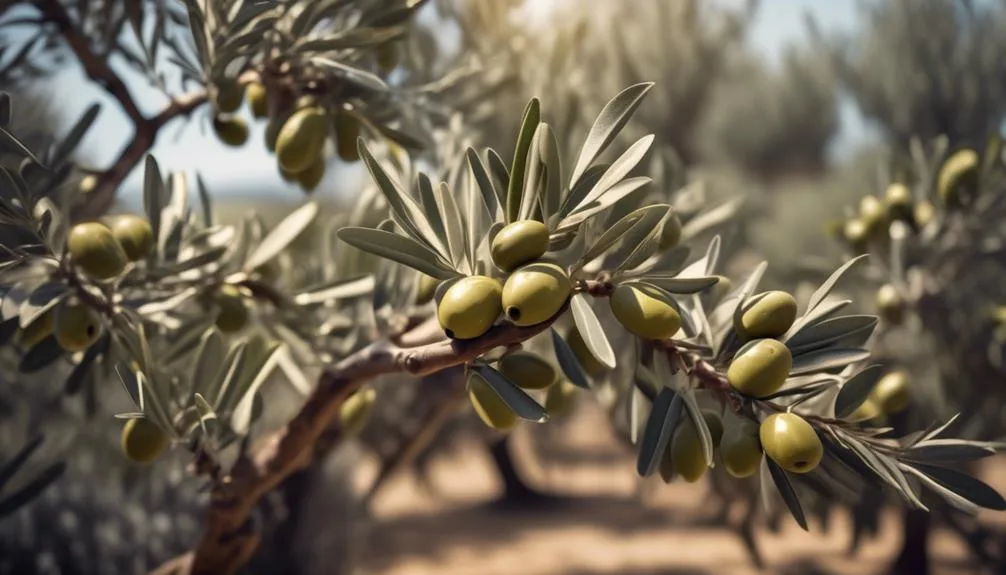Pruning olive trees may seem excessive, but it's essential for their health and productivity. It's not just about looks – regular trimming is crucial for the overall well-being of the tree.
But why exactly do olive trees need so much pruning? Let's take a closer look at the important reasons behind this practice.
Key Takeaways
- Pruning olive trees promotes fruit production by maximizing yield and improving pollination.
- It helps shape tree growth, creating a strong structure for easier management and harvesting.
- Regular pruning controls disease and pests by removing infected branches and encouraging airflow.
- Pruning improves overall tree health and enhances harvest yield by promoting the growth of fruit-bearing branches and allowing sunlight to penetrate the tree.
Promotes Fruit Production
To ensure optimal fruit production from your olive tree, regular pruning is essential to promote healthy growth and maximize yield. Pruning increases pollination by allowing better air circulation and reducing disease risk.
When you trim your olive tree, you create a more open canopy, which maximizes sunlight penetration to the lower branches. This direct exposure to sunlight encourages the development of fruiting wood and promotes better fruit quality.
Additionally, pruning helps maintain the tree at an ideal size, making it easier to harvest the olives. By shaping the tree through regular pruning, you're ensuring that it remains healthy and productive, ultimately leading to a bountiful olive harvest.
Shapes Tree Growth
Pruning your olive tree not only promotes fruit production but also plays a crucial role in shaping the growth of the tree for optimal health and yield.
By guiding the growth through pruning, you encourage strength in the tree's structure. This is important for the overall health of the tree and its ability to bear fruit. Regular pruning helps to discourage overgrowth, preventing the tree from becoming too dense and promoting better air circulation and sunlight exposure throughout the canopy.
Shaping the growth of your olive tree also allows for easier management and harvesting, as well as reducing the risk of disease by improving the tree's overall health. Properly shaped trees aren't only aesthetically pleasing but also ensure that the tree's energy is focused on producing high-quality fruit.
Controls Disease and Pests
Regular pruning of your olive tree is essential for controlling disease and pests, ensuring the overall health and productivity of the tree.
Pruning helps prevent infestation by removing dead or diseased branches that can attract pests and harbor disease. Additionally, by shaping the tree and thinning out dense areas, pruning encourages airflow, which is crucial for preventing the buildup of moisture that can lead to fungal diseases. Proper airflow also discourages pests that thrive in humid environments.
Improves Tree Health
Improving the health of your olive tree through proper pruning practices not only prevents disease and pests but also fosters a thriving and sustainable cultivation environment. By enhancing the tree's health, you can significantly increase its longevity and encourage new growth.
Here's how pruning contributes to the overall well-being of your olive tree:
- Disease Prevention: Regular pruning removes dead or diseased branches, reducing the risk of infections and promoting overall tree health.
- Improved Air Circulation: Proper pruning opens up the canopy, allowing better air circulation which reduces the likelihood of fungal diseases.
- Nutrient Distribution: Pruning helps direct the tree's resources to where they're most needed, promoting healthier growth and fruit production.
- Stress Reduction: Trimming excessive growth reduces stress on the tree, encouraging stronger, more resilient growth.
Pruning, therefore, plays a crucial role in promoting the health and vitality of your olive tree.
Enhances Harvest Yield
Enhancing the harvest yield of your olive tree can be achieved through strategic pruning techniques and proper care throughout the growing season.
Pruning helps increase productivity by promoting the growth of new fruit-bearing branches and removing dead or non-fruitful wood. By maintaining an open canopy structure, sunlight can penetrate the tree, improving fruit production. Additionally, pruning encourages the development of strong, healthy branches capable of supporting a larger yield.
When done correctly, pruning also enhances quality by ensuring that the tree's resources are focused on producing high-quality olives. It allows for better air circulation within the tree, reducing the risk of disease and pests, ultimately leading to a higher-quality harvest.
Proper pruning not only increases the quantity of olives but also improves their flavor and nutritional value.
Conclusion
Incorporating regular pruning into your olive tree care routine is crucial for promoting fruit production, maintaining tree health, and maximizing harvest yield. By shaping tree growth, controlling disease and pests, and ensuring overall tree vitality, pruning plays a vital role in the long-term success of your olive trees.
So, grab your pruning shears and start pruning to enjoy the benefits of a flourishing and productive olive tree. Happy pruning!

